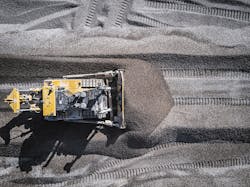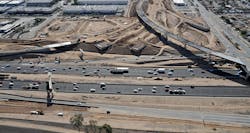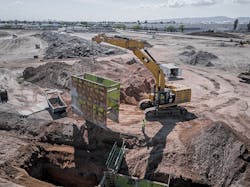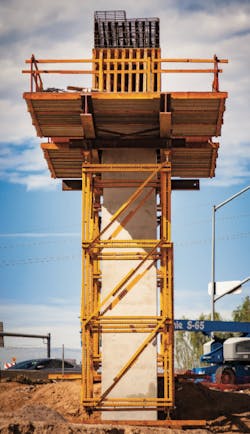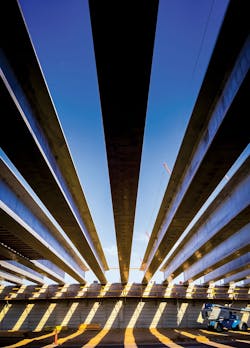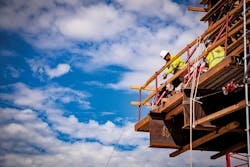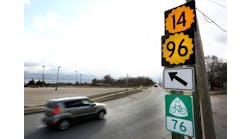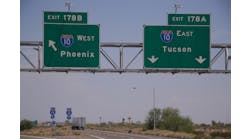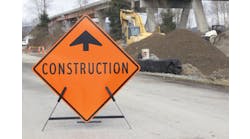More than one year after major construction began on the Loop 202 South Mountain Freeway, Arizona’s largest single highway project ever, progress has been swift.
Bridges have been built from the ground up, a massive amount of earth has been moved and compacted, and an emerging interchange has already changed the West Valley skyline in Phoenix.
The $1.7 billion freeway will provide a long-planned direct link between the East Valley and West Valley and a much-needed alternative to I-10 through downtown Phoenix. The Arizona Department of Transportation (ADOT) is currently targeting a late 2019 grand opening.
“We are building the South Mountain Freeway as a regional transportation solution,” ADOT Director John Halikowski said. “The need for a high-speed, efficient transportation corridor connecting the East and West Valleys dates back to the 1980s, when regional transportation planners foresaw the tremendous growth that was projected to occur in the area.
“Connecting people with employment centers and more in the East Valley and West Valley will benefit the region’s economy and quality of life; the current and projected population growth in Maricopa County has really driven the need to expand our transportation network throughout the region.”
This was ADOT’s goal when it finalized the state’s first highway public-private partnership with Connect 202 Partners in February 2016 to design, build and maintain the 22-mile freeway corridor. The freeway will run east and west along Pecos Road, and then north and south between 55th and 63rd avenues, connecting with I-10 on each end.
Connect 202 Partners is responsible for the design and construction of the freeway corridor, and will provide maintenance after construction. The joint venture is led by Fluor Corp., Granite Construction Co. and Ames Construction Inc., with Parsons Brinckerhoff Inc. (now WSP) as the lead designer. Maintenance services contractor DBI Services LLC will be jointly responsible for ongoing highway maintenance and any necessary capital improvements for 30 years after substantial completion.
The fixed $916 million contract for design and construction made this the largest single highway project in state history.
While the phrase “public-private partnership” may evoke visions of a toll road, that is not the case with the South Mountain Freeway project. Instead, this innovative agreement provides the advantages of lower cost and shorter timeline that come from having one team not only design and build the freeway, but maintain it afterward.
The original plan called for construction of the freeway as nine individual projects. But after receiving an unsolicited proposal for a public-private partnership in 2013, ADOT decided to seek proposals using that approach.
Connect 202 Partners was selected as the “best value” developer in December 2015 following an extensive review that led to a final list of three prospective developer teams in March 2015. ADOT encouraged these teams to propose innovative concepts that would save time and money while adhering to all environmental commitments.
Innovations proposed by Connect 202 Partners include optimizing the design of the freeway to reduce the amount of right-of-way needed, adding diverging diamond interchanges and improving efficiency by reducing the amount of earth needing to be hauled by trucks.
Even with the lower cost made possible by a P3 agreement, motorists will enjoy the same modern amenities they have been accustomed to for decades, including a high-capacity freeway with four lanes of traffic in each direction featuring high-occupancy vehicle (HOV) lanes, rubberized asphalt, access-controlled interchanges and aesthetics that reflect the nearby communities.
Through summer 2018, crews have installed 16 miles of drainage pipe, moved 7 million cu yd of dirt and used 8,600 tons of rebar manufactured from recycled steel.
More than halfway
The South Mountain Freeway is more than 50% complete from design to utilities to right-of-way acquisition to construction. Work is underway in 95% of the 22-mile corridor.
Through summer 2018, crews have installed 16 miles of drainage pipe, moved 7 million cu yd of dirt and used 8,600 tons of rebar manufactured from recycled steel.
In order to complete the freeway three years earlier, the project was split into four segments instead of the originally planned nine separate freeway projects:
- I-10 Papago segment (I-10 Papago traffic interchange south to Lower Buckeye Road and improvements to I-10 between 43rd and 75th avenues);
- Salt River segment (Lower Buckeye Road to 51st Avenue);
- Center segment (51st Avenue to 32nd Lane); and
- Pecos Road segment (32nd Lane to I-10 Maricopa/Loop 202 Santan Freeway traffic interchange).
The $1.7 billion South Mountain Freeway will provide a long-planned direct link between the East Valley and West Valley, and a much-needed alternative to I-10 through downtown Phoenix.
I-10 segment
Construction of the I-10 segment has arguably been the most challenging component of the South Mountain Freeway project. In addition to building 3 miles of new freeway, 4.5 miles of construction is occurring along I-10 between 43rd and 75th avenues. This area is one of the busiest stretches of highway in Arizona with more than 200,000 vehicles passing through this area daily.
Built in 1984, the I-10/59th Avenue traffic interchange is being reconstructed to link to the Loop 202 South Mountain Freeway when it opens to traffic in late 2019. The freeway-to-freeway interchange will allow motorists to be able to seamlessly connect from I-10 in the West Valley to a 22-mile-long South Mountain Freeway offering direct access to the East Valley.
The interchange will include five non-stop flyover ramps, new roadways parallel to I-10 between 51st and 67th avenues that will replace direct freeway access to 59th Avenue and improve traffic flow, and new auxiliary lanes that will feed traffic to the new freeway-to-freeway interchange. There also will be extensive resurfacing of I-10, new drainage structures, and new retaining and barrier walls.
“The challenge in building a freeway-to-freeway or system interchange is we are building freeway construction over, on and below I-10,” said Kole Dea, senior resident engineer for ADOT overseeing the I-10 Papago segment of the South Mountain Freeway. “That includes bridge work above, pavement work on and drainage work below.”
For Connect 202 Partners to complete this work safely, frequent lane restrictions and closures of I-10 are needed through the remainder of the project. But these are reserved for overnights and weekends, when traffic volumes are much lower.
“There is never a good time to close a freeway, particularly one as busy as I-10, but it’s absolutely necessary to ensure the safety of the traveling public and construction workers building the new South Mountain Freeway interchange,” Dea added.
The South Mountain Freeway project is more than 50% complete from design to utilities to right-of-way acquisition to construction. Work is underway in 95% of the 22-mile corridor. To complete the freeway three years earlier, the project was split into four segments instead of the originally planned nine separate freeway projects.
Salt River segment
The Salt River segment includes 7 miles of new freeway that passes through the rapidly growing southwest valley, including several agricultural areas and the Salt River.
This segment features the two longest bridges (northbound and southbound) on the project, at approximately 2,700 ft, or about a half-mile long. The bridges will provide another all-weather link to and from Laveen where the Salt River flows, while also reducing congestion at current crossings.
“Building another grade-separated crossing over the Salt River has been a critical transportation need in the growing Laveen area,” said Adam Brahm, resident engineer for ADOT, who oversees construction from Lower Buckeye Road to 51st Avenue. “When nearby low-flow crossings over the Salt River have become impassable, it has often created significant traffic delays in the area. The new Salt River bridges will make it easier for Laveen motorists to get where they need to go.”
After finishing setting all 292 precast concrete bridge girders, weighing up to 169,000 lb each and up to 170 ft long, and pouring the bridge deck this fall, Connect 202 Partners anticipates construction equipment utilizing this bridge late this year to aid construction efforts.
Center segment
Construction in the Center segment, located between 51st Avenue and 32nd Lane, includes a section passing through the southwestern edge of the South Mountain Park/Preserve, one of the largest municipal parks in the country at more than 16,000 acres.
Work did not begin in this rural area until spring 2018. Initial work has included geotechnical borings, plant salvage, controlled rock blasting and earthwork.
A significant amount of controlled rock blasting needs to be completed in 2019 along two ridges on the southwestern edge of the South Mountain Park to break large rock into smaller, more manageable pieces as crews create a path for the freeway. This stretch of freeway also will include five multi-use crossings and multiple drainage structures.
Pecos segment
The Pecos segment runs along the alignment of Pecos Road, which borders the Gila River Indian Community and the Phoenix urban village of Ahwatukee. This 9-mile stretch of freeway includes four traffic interchanges, including Arizona’s first diverging diamond interchanges at 17th Avenue and Desert Foothills Parkway.
The location of the freeway in this area helped influence the aesthetic design on the South Mountain Freeway. In the late 1920s, modern architect Frank Lloyd Wright arrived in Arizona to design a desert resort planned for the foothills of South Mountain, in what is now Ahwatukee.
To produce drawings for the project, Wright and his colleagues built a temporary desert settlement, near what is now 32nd Street and two-thirds of a mile north of what will be the Loop 202 South Mountain Freeway.
While the stock market crash of 1929 ended Wright’s project, nearly a century later his connection to the area will influence how drivers experience the South Mountain Freeway.
Working with the Frank Lloyd Wright Foundation, ADOT and its project team are honoring Wright as they design aesthetics for bridges, sound walls and other freeway elements.
Freeway sound-wall aesthetics include horizontal lines, featured in many of Wright’s designs, in different ways. The wood walls of Wright’s Ocatillo settlement featured bold horizontal lines to echo the desert floor and the area’s long horizons. This is contrasted with the vertical lines used along other Phoenix freeways.
“Frank Lloyd Wright had a strong presence at the base of South Mountain before Ahwatukee was even built,” said Joe Salazar, roadside development, project landscape and architecture coordinator for ADOT. “Wright was inspired by Arizona’s desert surroundings, and the South Mountain Freeway will tell that story.”
Paving pickup
With paving operations beginning in summer 2018 on the first mile of the freeway in the Salt River segment, mainline paving will pick up significantly in 2019 in all four freeway segments as ADOT and Connect 202 Partners move forward toward opening the South Mountain Freeway to traffic in late 2019.
Construction of the 13 traffic interchanges along the corridor also will be completed, along with a 6-mile-long shared-use path along the Pecos segment between 17th Avenue and 40th Street.
When it opens to traffic in late 2019, this long-planned link in the Phoenix metropolitan area will make this fast-growing region a better place to live and do business. And the completion of the project delivers on a promise to Maricopa County motorists to complete the 101 and Loop 202 system to connect communities and employment centers while helping position the Phoenix area for continued economic growth and opportunity.
You can learn more about the South Mountain Freeway project by visiting SouthMountainFreeway.com.
-----------
Information for this article provided by the Arizona DOT.

